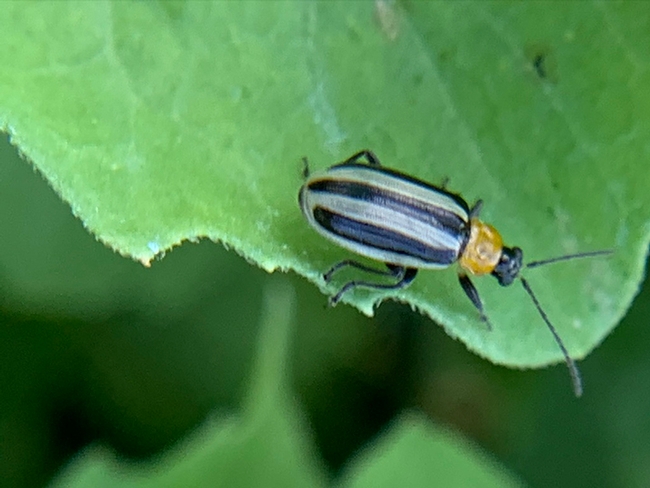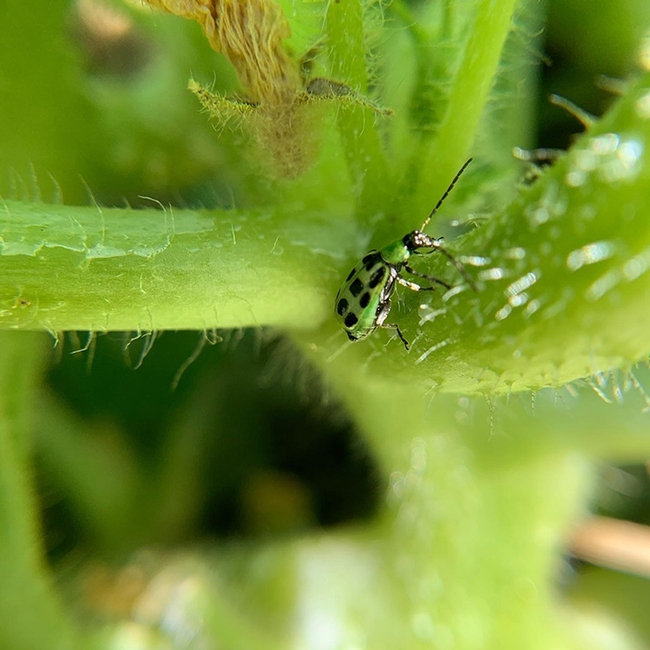
Other beetles--cucumber beetles--ravage agricultural crops, drawing millions of foes.
Enter Jasmin Ramirez Bonilla, a UC Davis graduate student in entomology, who is seeking to control these pests on melons through more effective integrated pest management (IPM) strategies.
Jasmin, who plans to complete her master's degree in the spring of 2022, recently presented her thesis proposal, “Advancing Integrated Pest Management Strategies for Cucumber Beetles in California,” to the UC Davis Department of Entomology and Nematology at a Zoom session.
“The beetle of focus for my thesis is the Western striped cucumber beetle, Acalymma trivittatum,” said Jasmin, who studies with major professor and agricultural entomologist Ian Grettenberger, a Cooperative Extension specialist in the UC Davis Department of Entomology and Nematology.“ A second species, the Western spotted cucumber beetle, Diabrotica undecimpunctata undecimpunctata--a milder pest but still a pest of melons-- is also part of my project but not the primary subject of my studies.”
Her thesis project consists of three objectives:
- Characterize the non-crop and overwintering habitat
- Clarify short-distance dispersal dynamics after harvest
- Evaluate the utility of the aggregation pheromone, vittatalactone
Both species feed on muskmelons, Cucumis melo. “These include honeydew melon, cantaloupe, crenshaw, and cassava,” she said. “However, Acalymma is the specialist.” Cucumber beetles are pests of plants in the Cucurbitaceae family,which includes melons, gourds, cucumbers, squash and pumpkin.
Of key concern is “the lack of effective IPM tools for the management of cucumber beetles, especially the western striped cucumber beetle,” she said. “There is a critical need to visit this system and revisit the ecology to have a clearer understanding of the non-crop habitat uses and dispersal dynamics to improve and optimize the scouting and monitoring strategies. In addition, one way to monitor and manage insect pests is using semiochemicals such as aggregation pheromones and kairomones—for example, cucurbit blossom volatiles--which are of interest to be combined and studied their efficacy attraction.”
Preliminary data for one of her experiments indicates that the synthetic aggregation pheromone, vittatalactone, attracts the western striped cucumber beetle and the spotted cucumber beetle. “This pheromone was mimicked from airborne volatiles produced by male beetles, Acalymma vittatum, the cousin of the western striped cucumber beetle,” Bonila related. “This pheromone is a potential monitoring tool for managing these beetles and minimize the intensive applications of insecticides on the field.”
What sparked her interest in entomology? When she worked as a field research assistant for six months in 2017 with the UC Cooperative Extension in Woodland and sampled Lygus damage in sunflower fields.
“After this field assistant position, I worked as a junior specialist on an alfalfa weevil project to improve management in alfalfa,” Jasmin related. This was a research grant of the late Larry Godfrey (1956-2017), an Extension entomologist based in the UC Davis Department of Entomology and Nematology. Godfrey, the principal investigator of the grant, worked with co-principal investigator Yolo County Farm Advisor Rachael Long until his death in April.
Long invited Jasmin to apply for the position. “That increased my interest in bugs,” Jasmin said. “There were so many different species and I was constantly collecting plethora of insects in each sample!”
A native of Guatemala, Jasmin moved to the United States at age 15 with her family. “Even though I wasn't born here, I still consider myself Guatemalan,” she related. “My family lives in Los Angeles and I attended Reseda High School in the San Fernando Valley.”
Jasmin, who received her bachelor's degree in earth system science at UC Merced in 2016, worked as a vegetation and ecological restoration intern with the National Park Service before enrolled in the UC Davis graduate program.
But it's the insects—particularly cucumber beetles—that fascinate her.
Attached Images:

Jasmin Ramirez Bonilla targets the Western striped cucumber beetle, Acalymma trivittatum. (Photo by Jasmin Ramirez Bonilla)

UC Davis graduate student Jasmin Ramirez Bonilla also targets the Western spotted cucumber beetle, Diabrotica undecimpunctata undecimpunctata--a milder pest but still a pest of melons. (Photo by Jasmin Ramirez Bonilla)